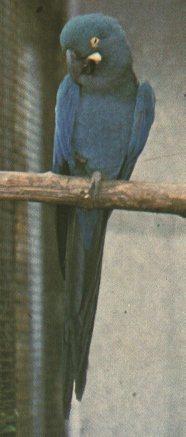|
| Query: hyacinth macaw | Result: 55th of 62 | |
Indigo Macaw (Anodorhynchus leari) <!--푸른금강앵무-->
| Subject: | Indigo Macaw (Anodorhynchus leari)
| |

| Resolution: 186x437
File Size: 14690 Bytes
Upload Date: 2005:03:14 20:07:48
|
From: santerre@accessone.com (Bug-a-Boo)
Newsgroups: alt.binaries.pictures.animals
Subject: Lears Macaw-- - learmcaw.jpg (1/1)
Date: Fri, 05 Jan 1996 09:02:37 GMT
Comments
========
From: proite@rudah.com.br
File To Comment: animal3/Lears_Macaw.jpg
The picture is pretty and I would like to know
if you have any information about Lear's macaw biology and more pictures.
I am a graduate student of University of Brasilia Brazil and I am doing
a monograph about it and the others Anodorhynchus, but I am finding a hard time
to discover information. Please if you do have any information, I would like to know.
Thanks and Regards, Karina Proite
|
Comments |
|---|
| | tearive wheeler |
|
| this is such a good picture i just like seeing anmial picture |
| | Guest |
|
Scientific Name: Anodorhynchus leari Bonaparte, 1856
Common Names:
English – Lear's Macaw, Indigo Macaw
Spanish – Guacamayo Cobalto, Guacamayo de Lear
Identification information: 70 cm. Large, blue macaw with yellow facial skin. Slightly paler blue on head. Long tail. Bare, yellow orbital area and lappets adjoining lower mandible. Large bill. Immature has shorter tails and paler yellow, bare facial skin. Similar spp. Hyacinth Macaw A. hyacinthinus is much larger; Glaucous Macaw A. glaucus is virtually indistinguishable, but slightly smaller and paler, and only escapees could occur within the range of A. leari. Voice Croaking and screeching sounds, notably higher-pitched and less guttural than A. hyacinthinus. |
| | Guest |
|
Scientific Name: Anodorhynchus leari Bonaparte, 1856
Common Names: Lear's Macaw, Indigo Macaw
French: Ara de Lear; German: Learara; Spanish: Guacamayo Cobalto, Guacamayo de Lear
Taxonomy: Anodorhynchus leari Bonaparte, 1856, no locality, presumed to have come from Brazil. |
^o^
Animal Pictures Archive for smart phones
^o^
|
|
|